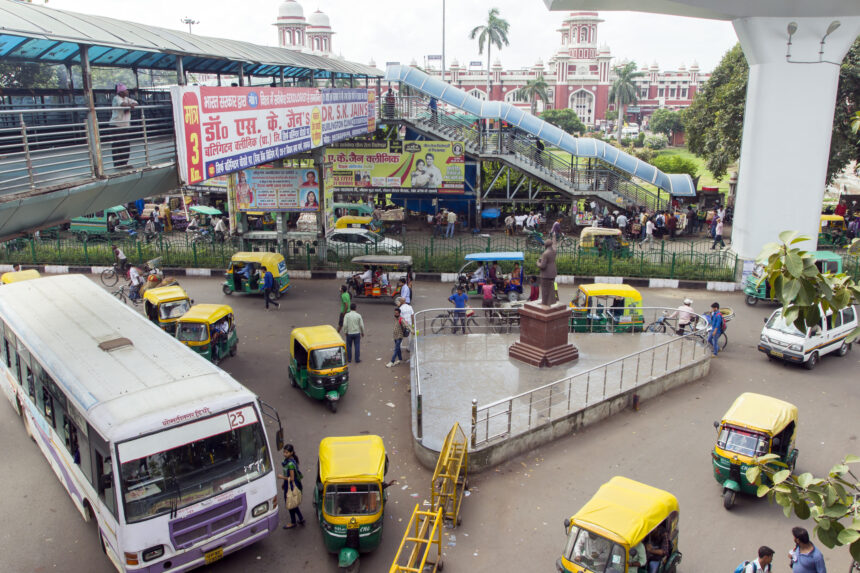A City Balancing Modern Transit Innovations with Persistent Challenges
Key Metrics:
- Metro Network: Lucknow Metro spans 23 kilometers with 21 operational stations, serving over 120,000 daily commuters (Lucknow Metro Rail Corporation, LMRC, 2024).
- Bus Network: The city operates 450 buses under the Uttar Pradesh State Road Transport Corporation (UPSRTC), covering 72 routes and catering to approximately 250,000 passengers daily (UPSRTC, 2024).
- Population Served: Lucknow’s public transport system serves a population of over 3.5 million, but gaps in last-mile connectivity remain significant (Census of India, 2021).
- Pollution Reduction: The introduction of electric buses has reduced annual emissions by 8%, as per a report by the Central Pollution Control Board (CPCB), 2024.
Lucknow, 2025 – As the capital of Uttar Pradesh and one of the fastest-growing cities in North India, Lucknow has taken significant steps to modernize its public transport infrastructure. The Lucknow Metro and the UPSRTC bus network aim to provide efficient and eco-friendly commuting options. However, issues like overcrowding, limited coverage, and insufficient integration between modes of transport persist. Is the city’s public transport system truly meeting the needs of its residents, or does it fall short of expectations?
Lucknow Metro: A Modern Solution with Gaps
The Lucknow Metro, operated by the Lucknow Metro Rail Corporation (LMRC), is one of the city’s most prominent public transport projects. The Red Line, running from Chaudhary Charan Singh Airport to Munshipulia, spans 23 kilometers and connects key residential and commercial hubs.
Benefits:
- Daily Ridership: Over 120,000 commuters use the metro daily, significantly reducing road congestion.
- Timely Service: Trains operate every 5-7 minutes during peak hours, ensuring a reliable commute.
- Eco-Friendly Impact: Powered by renewable energy sources, the metro has reduced carbon emissions by 10% since its launch.
Challenges:
- Limited Coverage: With only one operational line, the metro serves a fraction of the city. Expansions, including the proposed Blue Line, have faced delays due to funding and land acquisition issues.
- Last-Mile Connectivity: Commuters struggle to access metro stations due to inadequate feeder bus services and pedestrian pathways.
UPSRTC Buses: A Traditional Backbone Under Strain
Lucknow’s bus network, managed by the Uttar Pradesh State Road Transport Corporation (UPSRTC), is a vital mode of transport, particularly for low- and middle-income residents.
Benefits:
- Wide Reach: The 450 buses operate on 72 routes, covering both urban and suburban areas.
- Affordable Fare: Tickets range from ₹5 to ₹50, making buses the most economical option for daily commuters.
- Eco-Friendly Initiatives: The fleet includes 50 electric buses, contributing to a cleaner environment.
Challenges:
- Overcrowding: With only 450 buses for a population of 3.5 million, commuters often face overcrowded conditions, especially during peak hours.
- Aging Fleet: Over 30% of the buses are older than 10 years, leading to frequent breakdowns and delays.
- Inefficient Scheduling: Poor route planning and inconsistent service timings frustrate commuters, particularly in less-connected neighborhoods.
Voices from the Ground
Commuters express a mix of satisfaction and frustration with Lucknow’s public transport system.
“The metro is fast and reliable, but getting to the station is a hassle. More feeder buses or e-rickshaws would make a big difference,” says Ritu Verma, a daily metro user.
Bus passengers, however, highlight overcrowding and delays. “Sometimes, we have to wait 30 minutes or more for a bus. And when it comes, it’s packed beyond capacity,” says Mukesh Gupta, a regular commuter.
Environmental activists emphasize the need for integration. “While Lucknow has made strides with electric buses and the metro, the lack of coordination between these systems undermines their potential,” says Neha Tripathi, a member of the Clean Air Lucknow Initiative.
Government and Institutional Efforts
To address these issues, several initiatives have been launched:
- Metro Expansion: The proposed Blue Line, connecting East and West Lucknow, is expected to add 15 kilometers to the network by 2026 (LMRC).
- Fleet Modernization: UPSRTC plans to introduce 100 new electric buses by 2025 to improve service quality and reduce emissions (UPSRTC).
- Integrated Transport Hubs: The city is developing multimodal hubs at major intersections to connect buses, metros, and rickshaws seamlessly (Lucknow Smart City Mission).
- Digital Initiatives: Mobile apps for ticketing and live tracking have been introduced to enhance commuter convenience.
Recommendations for an Inclusive and Efficient System
To ensure Lucknow’s public transport system meets the needs of all residents, experts suggest:
- Expand Metro Coverage: Expedite construction of new lines and improve feeder services to enhance accessibility.
- Increase Bus Fleet: Add at least 300 new buses, focusing on underserved routes and peak-hour demand.
- Enhance Integration: Develop a unified ticketing system and synchronized schedules between buses and metros.
- Promote Non-Motorized Transport: Build pedestrian pathways and cycling tracks around metro stations and bus stops.
- Public Awareness Campaigns: Encourage the use of public transport through awareness programs highlighting affordability and environmental benefits.
A Path Forward
Lucknow’s public transport system has made significant progress, particularly with the introduction of the metro and eco-friendly buses. However, gaps in coverage, infrastructure, and integration continue to limit its effectiveness. The question remains: Can Lucknow evolve its public transport network to match its growing population, or will the city’s commuters remain underserved?


Leave a Reply